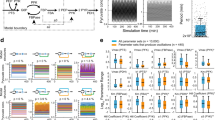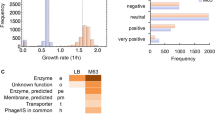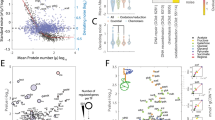Abstract
Elucidating the role of molecular stochasticity1 in cellular growth is central to understanding phenotypic heterogeneity2 and the stability of cellular proliferation3. The inherent stochasticity of metabolic reaction events4 should have negligible effect, because of averaging over the many reaction events contributing to growth. Indeed, metabolism and growth are often considered to be constant for fixed conditions5,6. Stochastic fluctuations in the expression level1,7,8,9 of metabolic enzymes could produce variations in the reactions they catalyse. However, whether such molecular fluctuations can affect growth is unclear, given the various stabilizing regulatory mechanisms10,11,12, the slow adjustment of key cellular components such as ribosomes13,14, and the secretion15 and buffering16,17 of excess metabolites. Here we use time-lapse microscopy to measure fluctuations in the instantaneous growth rate of single cells of Escherichia coli, and quantify time-resolved cross-correlations with the expression of lac genes and enzymes in central metabolism. We show that expression fluctuations of catabolically active enzymes can propagate and cause growth fluctuations, with transmission depending on the limitation of the enzyme to growth. Conversely, growth fluctuations propagate back to perturb expression. Accordingly, enzymes were found to transmit noise to other unrelated genes via growth. Homeostasis is promoted by a noise-cancelling mechanism that exploits fluctuations in the dilution of proteins by cell-volume expansion. The results indicate that molecular noise is propagated not only by regulatory proteins18,19 but also by metabolic reactions. They also suggest that cellular metabolism is inherently stochastic, and a generic source of phenotypic heterogeneity.
This is a preview of subscription content, access via your institution
Access options
Subscribe to this journal
Receive 51 print issues and online access
$199.00 per year
only $3.90 per issue
Buy this article
- Purchase on Springer Link
- Instant access to full article PDF
Prices may be subject to local taxes which are calculated during checkout



Similar content being viewed by others
References
Wilkinson, D. J. Stochastic modelling for quantitative description of heterogeneous biological systems. Nature Rev. Genet. 10, 122–133 (2009)
Eldar, A. & Elowitz, M. B. Functional roles for noise in genetic circuits. Nature 467, 167–173 (2010)
Heiden, M. G. V., Cantley, L. C. & Thompson, C. B. Understanding the Warburg effect: the metabolic requirements of cell proliferation. Science 324, 1029–1033 (2009)
Lu, H. P., Xun, L. Y. & Xie, X. S. Single-molecule enzymatic dynamics. Science 282, 1877–1882 (1998)
Fell, D. Understanding the Control of Metabolism (Portland, 1997)
Herrgard, M. J., Covert, M. W. & Palsson, B. O. Reconstruction of microbial transcriptional regulatory networks. Curr. Opin. Biotechnol. 15, 70–77 (2004)
Elowitz, M. B., Levine, A. J., Siggia, E. D. & Swain, P. S. Stochastic gene expression in a single cell. Science 297, 1183–1186 (2002)
Ferguson, M. L. et al. Reconciling molecular regulatory mechanisms with noise patterns of bacterial metabolic promoters in induced and repressed states. Proc. Natl Acad. Sci. USA 109, 155–160 (2012)
Munsky, B., Neuert, G. & van Oudenaarden, A. Using gene expression noise to understand gene regulation. Science 336, 183–187 (2012)
Neidhardt, F. C., Ingraham, J. L. & Schaechter, M. Physiology of the Bacterial Cell: A Molecular Approach (Sinauer, 1990)
Rodriguez, M., Good, T. A., Wales, M. E., Hua, J. P. & Wild, J. R. Modeling allosteric regulation of de novo pyrimidine biosynthesis in Escherichia coli. J. Theor. Biol. 234, 299–310 (2005)
Hart, Y. et al. Robust control of nitrogen assimilation by a bifunctional enzyme in E. coli. Mol. Cell 41, 117–127 (2011)
Klumpp, S., Zhang, Z. & Hwa, T. Growth rate-dependent global effects on gene expression in bacteria. Cell 139, 1366–1375 (2009)
Yun, H. S., Hong, J. & Lim, H. C. Regulation of ribosome synthesis in Escherichia coli: effects of temperature and dilution rate changes. Biotechnol. Bioeng. 52, 615–624 (1996)
el-Mansi, E. M. & Holms, W. H. Control of carbon flux to acetate excretion during growth of Escherichia coli in batch and continuous cultures. J. Gen. Microbiol. 135, 2875–2883 (1989)
Wilson, W. A. et al. Regulation of glycogen metabolism in yeast and bacteria. FEMS Microbiol. Rev. 34, 952–985 (2010)
Levine, E. & Hwa, T. Stochastic fluctuations in metabolic pathways. Proc. Natl Acad. Sci. USA 104, 9224–9229 (2007)
Pedraza, J. M. & van Oudenaarden, A. Noise propagation in gene networks. Science 307, 1965–1969 (2005)
Rosenfeld, N., Young, J. W., Alon, U., Swain, P. S. & Elowitz, M. B. Gene regulation at the single-cell level. Science 307, 1962–1965 (2005)
Dean, A. M. A molecular investigation of genotype by environment interactions. Genetics 139, 19–33 (1995)
Austin, D. W. et al. Gene network shaping of inherent noise spectra. Nature 439, 608–611 (2006)
Dunlop, M. J., Cox, R. S., III, Levine, J. H., Murray, R. M. & Elowitz, M. B. Regulatory activity revealed by dynamic correlations in gene expression noise. Nature Genet. 40, 1493–1498 (2008)
Scott, M., Gunderson, C. W., Mateescu, E. M., Zhang, Z. & Hwa, T. Interdependence of cell growth and gene expression: origins and consequences. Science 330, 1099–1102 (2010)
Goerke, B. & Stulke, J. Carbon catabolite repression in bacteria: many ways to make the most out of nutrients. Nature Rev. Microbiol. 6, 613–624 (2008)
Shen-Orr, S. S., Milo, R., Mangan, S. & Alon, U. Network motifs in the transcriptional regulation network of Escherichia coli. Nature Genet. 31, 64–68 (2002)
Walsh, K. & Koshland, D. E., Jr Characterization of rate-controlling steps in vivo by use of an adjustable expression vector. Proc. Natl Acad. Sci. USA 82, 3577–3581 (1985)
Wagner, A. et al. Computational evaluation of cellular metabolic costs successfully predicts genes whose expression is deleterious. Proc. Natl Acad. Sci. USA 110, 19166–19171 (2013)
Oh, M. K., Rohlin, L., Kao, K. C. & Liao, J. C. Global expression profiling of acetate-grown Escherichia coli. J. Biol. Chem. 277, 13175–13183 (2002)
Balazsi, G., van Oudenaarden, A. & Collins, J. J. Cellular decision making and biological noise: from microbes to mammals. Cell 144, 910–925 (2011)
Wang, Z. & Zhang, J. Impact of gene expression noise on organismal fitness and the efficacy of natural selection. Proc. Natl Acad. Sci. USA 108, E67–E76 (2011)
Acknowledgements
Work in the laboratory of S.J.T. is part of the research programme of the Foundation for Fundamental Research on Matter (FOM), which is part of the Netherlands Organisation for Scientific Research (NWO). D.J.K. was partly supported by an ETH Zurich Postdoctoral Fellowship. We thank T. Shimizu, J. van Zon, H. Bakker, K. Kuipers, M. Ackermann, P.-R. ten Wolde, M. Heinemann and members of the Tans group for reading the manuscript.
Author information
Authors and Affiliations
Contributions
D.J.K. and S.J.T. conceived and designed the experimental approach. D.J.K., P.N., N.W., V.S. and S.B. performed the experiments. P.N. developed the theoretical model. D.J.K., P.N. and S.J.T. wrote the manuscript.
Corresponding authors
Ethics declarations
Competing interests
The authors declare no competing financial interests.
Extended data figures and tables
Extended Data Figure 1 Image analysis and determination of cell length, elongation rate, enzyme concentration and production rate.
a, Segmented cell silhouettes are obtained by applying a Laplacian of Gaussian filter on phase contrast images. b, The cell axis is determined by fitting a third degree line through the silhouette. c, Cell-length determination. We compute the distances between points on the cell axis and the closest 25 segmentation pixels. The sum of these distances squared, here termed the silhouette proximity, is plotted for points along the cell axis. In the centre of the cell silhouette or mask, the silhouette proximity consistently remains at 4.06 μm2, but near the cell poles it rapidly increases. The location of each cell pole was taken at a silhouette-proximity of 4.47 μm2. d, Elongation rate of a single cell. The length of a single cell, its parent and its offspring plotted over time (dark circles). Instantaneous exponential elongation rate is determined by fitting an exponential to this data for a fraction of the cell cycle. At the beginning and end of each cell cycle, length data of the parent or the offspring are used for this fitting process (grey circles, see Supplementary Information). e, Initial fluorescence image. f, Image after background correction, shading correction and deconvolution by a point spread function. Total cell fluorescence is determined as the sum of fluorescence values within the cell silhouette. g, To determine the cellular fluorescence intensity that reports for the enzyme concentration accurately, we averaged the fluorescence values of pixels within a box of fixed width and equidistant length from the poles inside the cell perimeter. h, Enzyme production rate against time p(t) for all lineages within a microcolony, from 5 h into the experiment and onwards. Four lineages are coloured for clarity. Black bar, mean division time; light points, division events. i, Cell length against time L(t) as in h. j, Histograms of observed E values for different IPTG induction levels. Bottom panel indicates the noise intensity, defined as the standard deviation over the mean.
Extended Data Figure 2 Correlations between the growth rate of sister cells during growth on lactulose for increasing levels of IPTG induction.
a, At 4 µM IPTG, R = 0.72, n = 171, P < 10−27 (t-test). b, At 6 µM IPTG, R = 0.42, n = 382, P < 10−16. c, At 200 µM IPTG, R = 0.32, n = 314, P < 10−8. d, Evolution in time of the correlation coefficient between growth rate of sisters, for 6 µM IPTG. A decreasing exponential was fitted with a decay time of 2.86 h.
Extended Data Figure 3 Quantification of symmetry of cross-correlation functions.
For each cross-correlation (corresponding figure indicated at top), we computed the weighted average of the time delay  , with Rt the correlation intensity at time delay t, considering significantly cross-correlations (t-test, P < 0.05, n = 4) within the interval I = [−2, 2] cell cycles. A positive (respectively negative) τR indicates that the cross-correlation R has more weight at positive (respectively negative) times. Error bars denote the standard deviation of the symmetry values determined for four sub-branches. Note that the E–μ cross-correlations of Fig. 3c–d are negative, and hence we display −τR.
, with Rt the correlation intensity at time delay t, considering significantly cross-correlations (t-test, P < 0.05, n = 4) within the interval I = [−2, 2] cell cycles. A positive (respectively negative) τR indicates that the cross-correlation R has more weight at positive (respectively negative) times. Error bars denote the standard deviation of the symmetry values determined for four sub-branches. Note that the E–μ cross-correlations of Fig. 3c–d are negative, and hence we display −τR.
Extended Data Figure 4 Cross-correlations of control experiments and using different methods of growth-rate determination.
a, Expression of lac in a lacI repressor knockout strain on lactose minimal medium (to be compared with Fig. 2g). b, Expression of lac measured with a GFP fusion to LacZ shows same result as co-transcriptional expression of GFP on 0.1% lactulose and 6 μM of IPTG (to be compared with Fig. 2f). c, Exogenous constitutive promoter (PN25) driving the production of GFP, inserted in the cheZ locus, on minimal medium with lactose. d, The lac promoter driving the production of yellow fluorescent protein (YFP), inserted in the intC locus, on minimal medium with maltose. e, Cross-correlations for lactulose growth at low IPTG (4 μM), with growth rate determined as follows: S(t) is the surface area of the cell silhouette versus time (Extended Data Fig. 1a). The growth rate is the time derivative of S(t). f, The same, for lactulose growth at high IPTG (200 μM). g, Cross-correlations for lactulose growth at low IPTG (4 μM), with growth rate determined as follows: S(t) is the surface area of the cell silhouette versus time, L(t) is the length of the cell silhouette versus time (Extended Data Fig. 1b, c). The growth rate is the derivative of L(t) × [S(t)/L(t)]2. Note that S(t)/L(t) is taken as a measure for the width of the cell, and the width squared times the length as a measure for the cell volume. h, The same, for lactulose growth at high IPTG (200 μM). These cross-correlations display the same shape and symmetry as in Fig. 2e, g, where the growth rate is determined as the derivative of the length of the cell silhouette (Extended Data Fig. 1d). Hence the central features are robust to different methods of growth rate determination. i, Scatter plot of instantaneous growth rate and cell position within the microcolony. The cell position was calculated as the minimal distance of the centre of a cell to the edge of the microcolony. Data obtained during growth on lactulose at intermediate IPTG induction (6 μM).
Extended Data Figure 5 Cross-correlations for growth on different carbon sources.
a, Schematic diagram of noise transmission during growth on lactose, which is predicted to be similar to the case of growth on lactulose at high IPTG induction (see Fig. 2g, j). b, Corresponding measured cross-correlations. c, Theoretical cross-correlations obtained by using the parameters during growth on lactulose and changing exclusively the population average growth rate to the experimentally measured value. This prediction displays a positive asymmetric peak towards negative time and a width scaling with the average growth rate. d, Corresponding measured cross-correlations. e, Population average lac enzyme concentration versus the population average growth rate on minimal medium supplemented with varying carbon sources.
Extended Data Figure 6 External media perturbations in microfluidic device.
a, Growth of AB460 in microfluidic device (see Supplementary Information) on M9 medium with 0.1% lactulose, 0.01% Tween-20 and 16 μM IPTG. A 2-h pulse to medium with 3 μM IPTG is indicated in red. Black line is the mean, and grey area is the standard deviation, of approximately 60 cells. Indicated are the lac production rate (p), lac concentration (E) and cell growth rate (μ). The duration and intensity of the pulse was chosen to reflect the naturally occurring fluctuations in lac expression. Upon the pulse, the production rate transiently decreased, followed by a gradual transient decrease in lac concentration, and a transient decrease in growth rate. These data are consistent with the catabolism transmission mode (top). b, Growth of ASC631 in microfluidic device on M9 medium with 0.1% glucose, 0.01% Tween-20 and 1 mM IPTG. To mimic fluctuations in common components, a 1-h pulse of amino acids (Teknova M2104) added to the medium is indicated in green. Both growth and production rate increase immediately upon addition of amino acids, reflecting the common noise transmission mode (top). The enzyme concentration remained relatively stable, showing that for these perturbations the production increase and dilution increase cancelled each other. These data are consistent with the common noise mode (top).
Extended Data Figure 7 Cross-correlations of additional constructs.
a, Transmission from lac to another gene via growth (on 0.1% lactulose and 6 μM IPTG) shown by the asymmetric cross-correlations between lac production rate and mCherry production driven by the constitutive bla promoter. b, The same for lac production rate and mCherry driven by the mel promoter induced by 0.2% melibiose (ΔmelA strain). c, Symmetric cross-correlation between lac production rate p and other gene production rate p* predicted for growth on acetate (see d). d, Absence of transmission shown by the cross-correlation between lac production rate p and the mCherry production rate p* driven by the constitutive PN25 promoter, on minimal medium with 0.1% acetate, consistent with predictions (c). e, Cross-correlations (Rpμ) for lac, pfkA, gltA and icd in lactose (left) and acetate media (right).
Extended Data Figure 8 Extracting and weighing lineages from a branched data set.
a, Depiction of a growing microcolony over time, starting with two cells on the left and growing into five cells on the right. b, A lineage tree of the data shown in a. The tree starts with two lines (left), indicating the two starting cells, and at each division the line splits, resulting in five cells at the end (right). c, Five lineages can be extracted from the data. Note that most lineages share part of their data. When correlating data points from t0 with t1, one pair consists of completely independent data points (lineage I). Two lineages provide exactly the same pairs of data points (lineages IV and V), and two lineages only share a data point at t0 (lineages II and III). d, Different types of weighing for the correlation of data points from t0 with t1 as used in equation (6) in Supplementary Information. No: each lineage is weighed equally. Unique pairs: weighing such that only comparisons between unique data pairs are used. Unique points: lineages II and III are not completely independent, which can be corrected for by this weighing from equation (5) in Supplementary Information.
Supplementary information
Supplementary Information
This file contains Supplementary materials and Mehtods, Supplementary References, Supplementary Figures 1-5 and Supplementary Table 1. (PDF 1912 kb)
Rights and permissions
About this article
Cite this article
Kiviet, D., Nghe, P., Walker, N. et al. Stochasticity of metabolism and growth at the single-cell level. Nature 514, 376–379 (2014). https://doi.org/10.1038/nature13582
Received:
Accepted:
Published:
Issue Date:
DOI: https://doi.org/10.1038/nature13582
This article is cited by
-
Changes in interactions over ecological time scales influence single-cell growth dynamics in a metabolically coupled marine microbial community
The ISME Journal (2023)
-
A fast chemical reprogramming system promotes cell identity transition through a diapause-like state
Nature Cell Biology (2023)
-
Integrating glycolysis, citric acid cycle, pentose phosphate pathway, and fatty acid beta-oxidation into a single computational model
Scientific Reports (2023)
-
Dynamic fluctuations in a bacterial metabolic network
Nature Communications (2023)
-
Design and validation of a dual-fluorescence reporter system to monitor bacterial gene expression in the gut environment
Applied Microbiology and Biotechnology (2023)
Comments
By submitting a comment you agree to abide by our Terms and Community Guidelines. If you find something abusive or that does not comply with our terms or guidelines please flag it as inappropriate.



